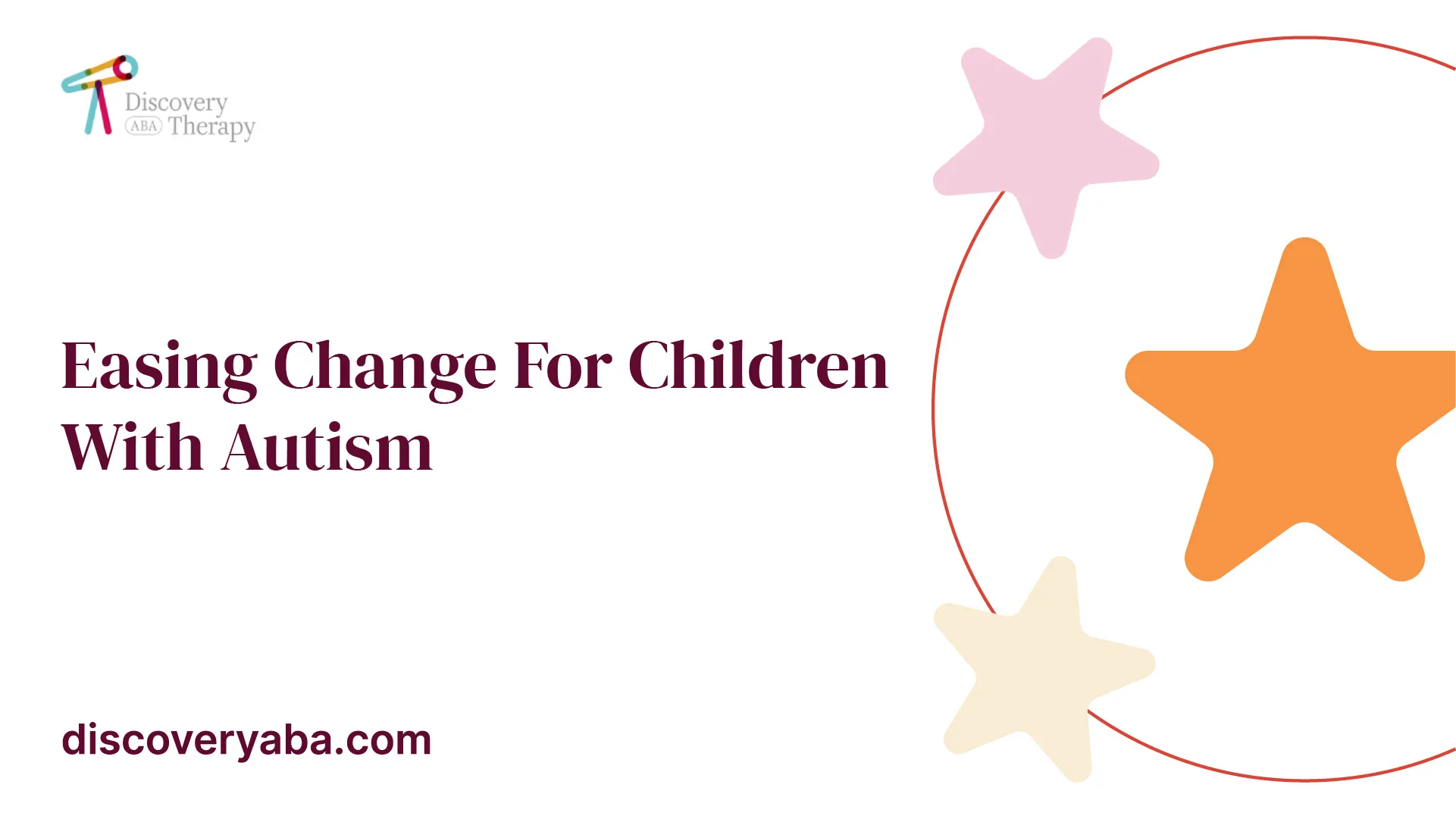Easing Change For Children With Autism
Embark on a heartfelt journey to ease change for children with autism. Delve into understanding and implementing compassionate strategies to navigate transitions with empathy and support.

Understanding Transitions for Children with Autism
Navigating transitions can be particularly challenging for children with autism. Changes in routines, environments, or activities can often cause stress and anxiety, leading to difficulties in adapting to new situations. Understanding why transitions can be challenging and the importance of providing support is essential in helping children with autism navigate these changes successfully.
Why Transitions Can be Challenging
Transitions can be challenging for children with autism due to a variety of factors. Some common reasons include:
- Difficulty with Flexibility: Children with autism often prefer routines and predictability. Any deviation from their established routine can cause distress and unease.
- Sensory Sensitivities: Many children with autism have sensory sensitivities, making them more prone to sensory overload during transitions. The new environment or changes in sensory stimuli can be overwhelming and lead to anxiety or meltdowns.
- Communication and Social Challenges: Children with autism may have difficulty understanding verbal instructions or social cues, making it harder for them to comprehend and navigate transitions.
- Executive Functioning: Difficulties with executive functioning, such as planning, organizing, and shifting attention, can make it harder for children with autism to transition smoothly between tasks or activities.

The Importance of Supporting Transitions
Supporting transitions is crucial for children with autism as it helps alleviate anxiety, promotes a sense of security, and facilitates smoother transitions. Some key reasons why supporting transitions is important include:
- Reducing Stress and Anxiety: Providing support during transitions helps reduce stress and anxiety for children with autism. By establishing predictability and routine, children feel more secure, knowing what to expect and how to navigate the changes.
- Promoting Independence: With appropriate support, children with autism can develop the skills needed to transition independently. This fosters their confidence and self-esteem, enabling them to adapt to new situations more effectively.
- Enhancing Communication and Social Skills: Supporting transitions provides opportunities to improve communication and social skills. By using visual supports or social stories, children can better understand and prepare for the upcoming changes.
- Improving Overall Well-being: Smooth transitions contribute to overall well-being for children with autism. When transitions are supported and successful, children experience a sense of accomplishment and are more likely to engage positively in new activities or environments.
Understanding the challenges children with autism face during transitions and recognizing the importance of providing support sets the foundation for implementing strategies and creating a supportive environment for their successful navigation through change.
Creating a Supportive Environment
When it comes to supporting children with autism during transitions, creating a supportive environment is key. By establishing predictability and routine, as well as utilizing visual supports, caregivers can help ease the challenges that can arise during transitions.
Establishing Predictability and Routine
For children with autism, predictability and routine can provide a sense of security and stability. Establishing a consistent daily schedule can help children anticipate and prepare for upcoming transitions. Here are some strategies to consider:
- Structured Schedule: Create a visual schedule that outlines the daily activities and transitions. This can be in the form of a calendar, a checklist, or a visual timeline. Ensure that the schedule is clearly visible and accessible to the child.
- Visual Cues: Use visual cues, such as pictures or symbols, to represent different activities or transitions. These cues can be placed on the schedule or in the environment to provide additional visual support and reinforce the routine.
- Transition Warnings: Give the child advance notice before a transition is about to occur. Use verbal reminders, timers, or visual countdowns to signal that a transition is approaching. This can help the child prepare mentally for the upcoming change.
Visual Supports for Transitions
Visual supports are effective tools for children with autism, as they provide a visual representation of information and help facilitate understanding. Here are some visual supports that can be beneficial during transitions:
- Visual Schedules: As mentioned earlier, visual schedules can be an invaluable tool for supporting transitions. They provide a clear visual representation of the sequence of activities and help the child understand what comes next.
- Visual Timers: Use visual timers, such as hourglasses or countdown clocks, to indicate the duration of an activity or the time remaining until a transition. These timers provide a concrete visual representation of time, helping the child grasp the concept of time passing.
- Social Stories: Social stories are visual narratives that depict a specific situation or transition. They can be used to explain the steps involved in a transition and prepare the child for what to expect. Social stories can help reduce anxiety and increase comprehension.
By establishing predictability and routine, and incorporating visual supports, caregivers can create a supportive environment that eases transitions for children with autism. These strategies promote a sense of security and provide the necessary structure for a smooth transition experience. Remember, each child is unique, so it's important to tailor these approaches to fit the individual needs and preferences of the child.
Strategies for Smooth Transitions
Children with autism often face difficulties during transitions, but with the right strategies in place, these transitions can become smoother and more manageable. Here are some effective strategies to support children with autism during transitions:
Providing Advance Notice and Warnings
Giving children advance notice and warnings about upcoming transitions can help prepare them for the change and reduce anxiety. Clearly communicate the transition in a language they understand, using visual supports if necessary. For example, you can use a visual schedule or a calendar to visually represent the transition and provide a countdown to the event.
It's important to be consistent with the timing and language used for the advance notice. This predictability helps the child understand what to expect and mentally prepare for the transition. Using visual timers or auditory cues can further enhance their understanding of how much time is left before the transition occurs.
Using Timers and Countdowns
Timers and countdowns are valuable tools for children with autism, as they provide a visual representation of time passing. These tools can help establish a sense of structure and predictability during transitions. Use a timer or a countdown clock to indicate how much time is remaining before the transition occurs.
By setting clear expectations and providing a visual representation of time, children with autism can better understand the concept of waiting and be more prepared for the upcoming change. This can help reduce anxiety and promote a smoother transition.
Social Stories and Role-Playing
Social stories and role-playing are effective techniques for preparing children with autism for transitions. Social stories are narratives that provide information about specific situations or events in a structured and visual manner. They can be customized to address the specific transition the child will be experiencing, helping them understand what to expect and how to navigate the change.
Role-playing is another beneficial strategy that allows children to practice and rehearse the transition in a safe and controlled environment. This hands-on approach can help them become more familiar with the steps involved in the transition and build their confidence.
Using social stories and engaging in role-playing activities can empower children with autism by providing them with a clearer understanding of the transition and the necessary skills to navigate it successfully.
By implementing these strategies, caregivers and educators can support children with autism during transitions, making the process smoother and more manageable. Remember, each child is unique, so it's important to tailor these strategies to their individual needs and preferences. With patience, consistency, and a supportive environment, children with autism can navigate transitions with greater ease and confidence.
Sensory Considerations
Children with autism often experience sensory sensitivities, which can make transitions particularly challenging for them. Understanding and addressing these sensory considerations can greatly support children in successfully navigating transitions.
Sensory Supports for Transitions
Providing sensory supports during transitions can help children with autism feel more comfortable and secure. These supports can help regulate their sensory experiences and reduce anxiety. Here are some sensory supports that can be beneficial:
Sensory Support and Description
- Visual Cues: Visual cues, such as visual schedules or timers, can help children understand the sequence of events and anticipate transitions. These visual supports provide a clear visual representation of what is going to happen next.
- Auditory Supports: Auditory supports, like calming music or white noise machines, can help create a soothing auditory environment during transitions. These sounds can help drown out disruptive noises and provide a sense of calmness.
- Tactile Supports: Tactile supports, such as stress balls or fidget toys, can provide sensory input and help children focus and self-regulate during transitions. These objects can offer a calming and grounding effect.
- Weighted Items: Weighted blankets, vests, or lap pads can provide deep pressure input, which has a calming and organizing effect on the sensory system. These weighted items can help children feel more secure and regulated during transitions.
- Sensory Breaks: Offering sensory breaks before or after transitions can help children regulate their sensory systems. These breaks provide opportunities for children to engage in sensory activities that help them calm down or re-energize, depending on their individual needs.
Minimizing Sensory Overload
Minimizing sensory overload is crucial in supporting children with autism during transitions. Here are some strategies to minimize sensory overload:
- Create a quiet and calm environment: Reduce unnecessary noise and distractions in the environment. This can include turning off loud electronics, closing doors to minimize outside noise, and providing a designated quiet space for the child to retreat to if needed.
- Control lighting: Adjust the lighting to a level that is comfortable for the child. Dimming lights or using natural light can help create a soothing environment.
- Consider clothing and textures: Be mindful of the clothing and textures that may cause discomfort or sensory overload for the child. Choose clothing made from soft and non-irritating fabrics.
- Be aware of smells: Some children with autism may be sensitive to certain smells. Avoid overwhelming scents or use calming scents, like lavender, if the child finds them soothing.
- Plan for transitions during less crowded times: Avoid peak times or crowded areas when possible. This reduces the risk of sensory overload from excessive noise, movement, or visual stimulation.
By implementing sensory supports and minimizing sensory overload, caregivers and educators can create a more supportive environment for children with autism during transitions. These strategies help to alleviate sensory challenges, reduce anxiety, and promote a smoother transition experience for the child.
Collaboration and Communication
Supporting children with autism during transitions requires a collaborative approach involving educators, therapists, and caregivers. By working together and maintaining open communication channels, everyone involved can ensure a smooth and successful transition for the child.
Working with Educators and Therapists
Collaboration with educators and therapists is essential in providing consistent support for children with autism during transitions. Educators and therapists play a crucial role in understanding the child's needs and implementing appropriate strategies in school or therapy settings. By sharing information and observations, caregivers can help educators and therapists better understand the child's unique challenges and strengths.
Regular meetings and discussions between caregivers and educators/therapists can foster a collaborative environment. These discussions can focus on the child's progress, any difficulties encountered during transitions, and strategies that have been effective. By working together, caregivers and professionals can create a unified plan tailored to the child's specific needs and goals.
Open Communication with the Child
In addition to collaborating with educators and therapists, open communication with the child is equally important. Engaging the child in conversations about transitions can help them understand what to expect and reduce anxiety. Here are some strategies for open communication:
- Use clear and concise language: When discussing transitions, use simple and concrete language to ensure the child understands the information being conveyed.
- Visual supports: Visual aids, such as schedules, social stories, or visual timetables, can facilitate communication and provide a visual representation of the transition process.
- Ask for input: Encourage the child to express their preferences and concerns about transitions. This can help them feel empowered and involved in the process.
- Validate emotions: Recognize and validate the child's emotions during transitions. Let them know that it's okay to feel a certain way and provide reassurance and support.
By maintaining open communication with the child, caregivers can better understand their needs and perspective. This ensures that the child feels heard, supported, and included in the transition process.
Collaboration and communication are key factors in supporting children with autism during transitions. By working closely with educators, therapists, and the child, caregivers can provide a supportive environment that promotes successful and positive transitions.
Celebrating Progress
Supporting children with autism during transitions requires patience, understanding, and a celebratory mindset. Recognizing and celebrating successful transitions can be a powerful way to motivate and reinforce positive behavior. Here are some strategies to celebrate progress and make transitions a positive experience for children with autism.
Recognizing and Celebrating Successful Transitions
Acknowledging and praising a child's successful transition is essential for building their confidence and self-esteem. By recognizing their accomplishments, you create a positive association with transitions and motivate them to continue improving. Here are some ways to celebrate successful transitions:
Celebration Ideas
- Verbal praise and encouragement
- High-fives or fist bumps
- Stickers or small rewards
- Special privileges or activities
- Certificates of achievement
Remember that each child is unique, and what motivates one may not work for another. It's important to understand the child's interests and preferences to design appropriate celebrations that resonate with them. Celebrating in a way that is meaningful to the child can make the experience more enjoyable and reinforce their progress.
Encouragement and Positive Reinforcement
In addition to celebrating successful transitions, providing ongoing encouragement and positive reinforcement is crucial. This helps children with autism stay motivated and confident during periods of change. Here are some strategies for offering encouragement and positive reinforcement:
Positive Reinforcement Strategies
- Provide specific and descriptive praise, highlighting the child's effort and progress
- Use visual rewards charts or token systems to track and reward successful transitions
- Offer verbal prompts and reminders to reinforce desired behaviors during transitions
- Incorporate preferred activities or interests as rewards for successful transitions
- Involve family members, teachers, and therapists in providing positive reinforcement
Consistency is key when implementing positive reinforcement strategies. By consistently providing praise and rewards for successful transitions, you can help children with autism develop a positive attitude towards change and build their confidence in handling transitions.
Remember, supporting children with autism in transitions is an ongoing process. By recognizing and celebrating their progress, you can create a supportive and encouraging environment that fosters their growth and development.
Summary
As we draw to a close on the topic of easing change for children with autism, it's essential to recognize the power of empathy, patience, and understanding in this journey. These children are not just navigating change; they're embarking on a path that requires our unwavering support, compassion, and acknowledgment of their unique experiences.
In the realm of autism, change isn't merely a challenge; it's an opportunity for growth and connection. It's about creating a world where every child, regardless of their neurodiversity, can flourish and feel secure amidst transitions. As parents, caregivers, and advocates, our role is not just to manage change but to embrace it with open hearts, recognizing the potential for resilience, learning, and the beautiful tapestry of diversity that each child brings.
So, let's continue this journey together, weaving a narrative of acceptance, understanding, and a commitment to making the world a more inclusive place for children with autism. In every small step towards easing change, we're not just supporting these children; we're celebrating their unique journey and contributing to a world that cherishes and uplifts every individual, one change at a time.
Sources
- https://lifeskillsadvocate.com/blog/autism-transitions-strategies-to-ease-changes-in-routine
- https://iidc.indiana.edu/irca/articles/transition-time-helping-individuals-on-the-autism-spectrum-move-successfully-from-one-activity-to-another
- https://raisingchildren.net.au/autism/behaviour/understanding-behaviour/changing-routines-asd
Does Your Child Have An Autism Diagnosis?
Learn More About How ABA Therapy Can Help
Find More Articles
Contact us
North Carolina, Nevada, Utah, Virginia
New Hampshire, Maine
Arizona, Colorado, Georgia, New Mexico, Oklahoma, Texas
.avif)




































































































